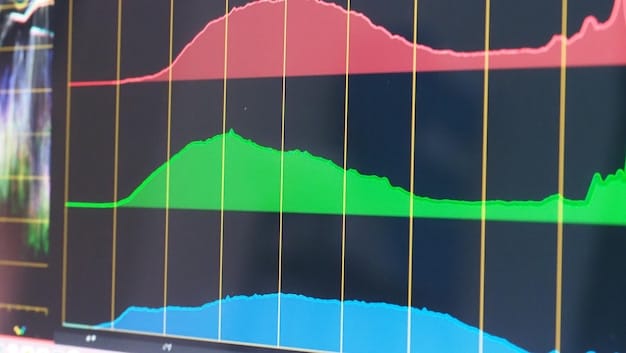Income REIT Due Diligence: Key Metrics for Smart Investing

Income REIT due diligence involves evaluating key financial metrics like FFO, AFFO, dividend yield, payout ratio, debt levels, occupancy rates, and property diversification to assess the investment’s profitability and stability.
Investing in Income REITs can be a rewarding venture, but it requires careful consideration. This article delves into income REIT due diligence, outlining seven key metrics to analyze before investing, ensuring you make informed and profitable decisions.
Understanding Income REITs and Their Appeal
Real Estate Investment Trusts (REITs) are companies that own or finance income-producing real estate across a range of property sectors. Income REITs, specifically, are popular for their ability to generate steady income streams for investors through dividends. Understanding their appeal is the first step in effective due diligence.
REITs offer several advantages, including diversification within the real estate market without direct property ownership, liquidity through publicly traded shares, and the potential for both income and capital appreciation. However, like any investment, they come with risks that need careful evaluation.
Key Metrics for Income REIT Due Diligence
Before investing in an income REIT, it’s crucial to perform thorough due diligence. This involves analyzing several key financial metrics to assess the REIT’s profitability, stability, and overall financial health.

Funds From Operations (FFO)
Funds From Operations (FFO) is a critical metric that measures a REIT’s cash flow from its operations. It is calculated by adding depreciation and amortization expenses back to net income and then subtracting any gains from property sales.
FFO provides a more accurate picture of a REIT’s operating performance compared to net income, which can be distorted by depreciation and gains from property sales. A higher FFO generally indicates better financial health.
Adjusted Funds From Operations (AFFO)
Adjusted Funds From Operations (AFFO) takes FFO a step further by accounting for recurring capital expenditures and other non-cash items that can affect a REIT’s cash flow. AFFO is often considered a more conservative and reliable measure of a REIT’s earnings.
- Recurring Capital Expenditures: These are the regular investments needed to maintain a property’s condition and competitiveness.
- Straight-Lining of Rents: Adjustments for differences between actual cash rents received and the reported rental income.
- Tenant Improvements and Leasing Commissions: Costs associated with attracting and retaining tenants.
By analyzing AFFO, investors can gain a clearer understanding of the REIT’s true cash-generating ability and its capacity to sustain dividend payouts.
FFO and AFFO are vital indicators of a REIT’s financial health, providing a more realistic view of its operational performance and ability to generate consistent income.
Dividend Yield and Payout Ratio
Dividend yield and payout ratio are two essential metrics for evaluating the income potential and sustainability of a REIT’s dividends. These metrics help investors understand how much income they can expect and whether the REIT can maintain its dividend payments.

Dividend Yield
The dividend yield is the annual dividend payment an investor receives relative to the stock’s price. It is calculated by dividing the annual dividend per share by the current stock price.
A higher dividend yield can be attractive, but it’s essential to consider whether the yield is sustainable. Extremely high yields might indicate that the REIT’s stock price is depressed due to financial challenges, or that the dividend payout is unsustainable.
Payout Ratio
The payout ratio is the percentage of a REIT’s earnings that it pays out as dividends. It is calculated by dividing the total dividends paid by either FFO or AFFO.
A high payout ratio can signal that the REIT is distributing most of its earnings as dividends, leaving less for reinvestment in its properties or debt reduction. A sustainable payout ratio typically ranges between 70% and 85% of AFFO.
Comparing REITs
Comparing dividend yields and payout ratios across different REITs can help investors identify those that offer attractive income opportunities with sustainable dividend policies. However, remember to consider other factors like the REIT’s financial health and growth prospects.
Analyzing dividend yield and payout ratio provides insights into the income potential and sustainability of a REIT’s dividends, aiding investors in making informed decisions.
Debt Levels and Leverage
Debt levels and leverage are crucial indicators of a REIT’s financial risk. High debt levels can increase a REIT’s vulnerability to economic downturns and interest rate increases, making it essential to evaluate these metrics carefully.
REITs often use debt to finance property acquisitions and developments. While leverage can boost returns in a favorable market, it can also amplify losses if properties underperform or interest rates rise.
- Debt-to-Asset Ratio: This ratio measures the proportion of a REIT’s assets that are financed by debt. A lower ratio generally indicates lower financial risk.
- Interest Coverage Ratio: This ratio measures a REIT’s ability to cover its interest expenses with its earnings. A higher ratio indicates a greater ability to meet its debt obligations.
- Debt Maturity Schedule: Analyzing the timing of a REIT’s debt maturities can provide insights into its refinancing risk. A well-staggered maturity schedule reduces the risk of having to refinance a large amount of debt at unfavorable rates.
By assessing these debt-related metrics, investors can gauge a REIT’s financial stability and its ability to manage its debt obligations effectively.
Assessing debt levels and leverage helps investors understand the financial risks associated with a REIT and its capacity to withstand economic challenges.
Occupancy Rates and Lease Terms
Occupancy rates and lease terms are key indicators of a REIT’s operational health and revenue stability. High occupancy rates and favorable lease terms translate to consistent rental income and reduced vacancy risk.
REITs with high occupancy rates are better positioned to generate stable cash flows and maintain dividend payouts. Understanding the terms of their leases is also crucial for assessing future revenue streams.
Occupancy Rates
Occupancy rate is the percentage of a REIT’s leasable space that is currently occupied by tenants. A high occupancy rate indicates strong demand for the REIT’s properties and efficient property management.
- Geographic Location: Properties in prime locations with high demand tend to have higher occupancy rates.
- Property Type: Different property types (e.g., office, retail, residential) may have varying occupancy rates depending on market conditions.
Lease Terms
Lease terms, including the length of leases and rental escalation clauses, can significantly impact a REIT’s revenue predictability. Longer lease terms provide more stable income streams, while rental escalation clauses can protect against inflation.
- Lease Expirations: Analyzing the timing of lease expirations can help investors anticipate potential vacancy risks and plan accordingly.
- Rental Escalation Clauses: These clauses allow for periodic rent increases, which can boost revenue and offset rising operating expenses.
By analyzing occupancy rates and lease terms, investors can gain insights into a REIT’s ability to generate consistent and predictable income.
Evaluating occupancy rates and lease terms offers valuable insights into the stability and predictability of a REIT’s rental income.
Property Diversification
Property diversification is an essential factor in assessing the risk profile of an income REIT. Diversifying across different property types and geographic locations can reduce the impact of localized economic downturns or industry-specific challenges.
REITs that concentrate their investments in a single property type or geographic area are more vulnerable to adverse events that affect that specific sector or region.
Diversification by Property Type
Investing in a mix of property types (e.g., office, retail, industrial, residential) can cushion the impact of downturns in any single sector. For example, during an economic recession, demand for office space might decline, while demand for residential properties remains stable.
Diversification by Geographic Location
Spreading investments across different geographic regions can mitigate the risk of localized economic downturns. A REIT with properties in multiple states or countries is less likely to be severely impacted by a recession in a single region.
Benefits of Diversification
Diversification can lead to more stable and predictable cash flows, as downturns in one area can be offset by stronger performance in others. This can help the REIT maintain its dividend payouts and weather economic storms.
Analyzing property diversification helps investors understand the risk mitigation strategies employed by a REIT and its ability to generate consistent returns across different market conditions.
Assessing property diversification is crucial for understanding the risk profile of a REIT and its resilience to economic shocks.
Management Quality and Track Record
Management quality and track record are critical qualitative factors that can significantly impact a REIT’s performance. Evaluating the experience, expertise, and integrity of the management team is essential for assessing the long-term prospects of the investment.
A strong management team can navigate challenging market conditions, make strategic decisions, and effectively manage the REIT’s operations, leading to better returns for investors.
Experience and Expertise
The management team should have a proven track record of success in the real estate industry. Their experience in property management, acquisitions, and financing can be invaluable in guiding the REIT’s growth.
- Previous Roles: Consider the management team’s previous roles and accomplishments in the real estate sector.
- Industry Knowledge: Assess their understanding of market trends, regulatory changes, and competitive dynamics.
Strategic Decision-Making
Evaluate the management team’s strategic decisions over time, including property acquisitions, development projects, and capital allocation policies. A well-thought-out strategy can drive long-term value creation.
- Growth Plans: Assess the REIT’s growth strategy and its potential to generate sustainable returns.
- Capital Allocation: Evaluate how the management team allocates capital to maximize shareholder value.
Assessing management quality and track record provides insights into the leadership capabilities and strategic vision driving the REIT’s performance.
Evaluating management quality and track record is crucial for understanding the leadership and strategic decision-making that drive a REIT’s success.
| Key Metric | Brief Description |
|---|---|
| 🏢 FFO & AFFO | Measures cash flow; AFFO adjusts for recurring capital expenditures, providing a more conservative view. |
| 💰 Dividend Yield | Annual dividend payment relative to stock price; indicates income potential. |
| 📊 Debt Levels | Debt-to-asset ratio and interest coverage ratio indicate financial risk. |
| 📈 Occupancy Rates | Percentage of leasable space occupied; indicates property demand and management efficiency. |
Frequently Asked Questions (FAQ)
▼
FFO, or Funds From Operations, is crucial as it provides a clearer picture of a REIT’s cash flow by adding depreciation back to net income, offering a more accurate view of operational performance.
▼
Diversification across property types and geographic locations reduces risk by mitigating the impact of localized economic downturns or industry-specific challenges, promoting stable cash flows.
▼
A healthy dividend payout ratio for an Income REIT typically falls between 70% and 85% of AFFO, indicating a sustainable balance between dividend payments and reinvestment in properties.
▼
Occupancy rates are important because they reflect the demand for a REIT’s properties and indicate how efficiently the REIT is managing its assets, directly impacting its revenue streams.
▼
High debt levels can increase a REIT’s vulnerability to economic downturns and rising interest rates, making it essential to assess metrics like the debt-to-asset ratio to gauge financial risk.
Conclusion
Performing thorough income REIT due diligence by analyzing these seven key metrics—FFO, AFFO, dividend yield, payout ratio, debt levels, occupancy rates, property diversification, and management quality—can significantly enhance your investment decisions, leading to more informed and profitable outcomes in the Income REIT sector.





